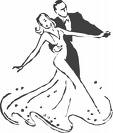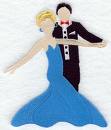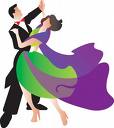The Ballroom Dances
There are a number of dances within the ballroom section, including five main dances which are included in the international competition scene...
The Waltz
 The world reknowned Waltz captures romance and marks special occasions for dancers everywhere. Originally an 18th century Austrian folk-dance, the Waltz is one of the five dances of International Ballroom competitions. The dance is called the 'slow' or 'English' Waltz in countries where the Viennese Waltz is known as the Waltz. It is counted in steps of three, and has graceful sway, and rise and fall.
The world reknowned Waltz captures romance and marks special occasions for dancers everywhere. Originally an 18th century Austrian folk-dance, the Waltz is one of the five dances of International Ballroom competitions. The dance is called the 'slow' or 'English' Waltz in countries where the Viennese Waltz is known as the Waltz. It is counted in steps of three, and has graceful sway, and rise and fall.
The Foxtrot
 The Foxtrot is a slow and graceful dance rooted in the Tin Pan Ally of the 1920s. The dance's elegant and beautiful movements make the Foxtrot a challenging dance for ballroom dancers to master. The Foxtrot features in the five International Ballroom competition dances.
The Foxtrot is a slow and graceful dance rooted in the Tin Pan Ally of the 1920s. The dance's elegant and beautiful movements make the Foxtrot a challenging dance for ballroom dancers to master. The Foxtrot features in the five International Ballroom competition dances.
The Quickstep
 The first dancers to take the Foxtrot to a faster tempo introduced the Quickstep. There are echoes of Charleston in the Quickstep with the dance's nimble hops and kicks, making it a lively and energetic expedition to the dancefloor. The Quickstep is one of the five international ballroom competition dances.
The first dancers to take the Foxtrot to a faster tempo introduced the Quickstep. There are echoes of Charleston in the Quickstep with the dance's nimble hops and kicks, making it a lively and energetic expedition to the dancefloor. The Quickstep is one of the five international ballroom competition dances.
The Tango
 The Ballroom Tango is one of the five dances belonging to the International Ballroom Competitions. Many see it as the austere European relative of the raw and compelling Tango Argentino. It is a much sharper and staccato dance than the others.
The Ballroom Tango is one of the five dances belonging to the International Ballroom Competitions. Many see it as the austere European relative of the raw and compelling Tango Argentino. It is a much sharper and staccato dance than the others.
The Viennese Waltz
 The Viennese Waltz harks back to days when the Viennese aristocracy danced to the music of Strauss and other classical composers. Today the Viennese Waltz is still danced socially, but the 'slow' or 'English' Waltz is more standard. Elegant and classic, the Viennese Waltz is one of the International Ballroom competition dances.
The Viennese Waltz harks back to days when the Viennese aristocracy danced to the music of Strauss and other classical composers. Today the Viennese Waltz is still danced socially, but the 'slow' or 'English' Waltz is more standard. Elegant and classic, the Viennese Waltz is one of the International Ballroom competition dances.
The Argentine Tango
 Argentine Tango was born in Buenos Aires and is a raw and authentic dance which, like many Latin dances, explores and tests the relationship between man and woman. In Argentine Tango the man and woman are equal and with the movements weaving contact and separation, the dance suggests that either partner may be seduced. In Europe, we have translated the original Argentine Tango into the Ballroom Tango, although the Argentine Tango is now regaining its popularity.
Argentine Tango was born in Buenos Aires and is a raw and authentic dance which, like many Latin dances, explores and tests the relationship between man and woman. In Argentine Tango the man and woman are equal and with the movements weaving contact and separation, the dance suggests that either partner may be seduced. In Europe, we have translated the original Argentine Tango into the Ballroom Tango, although the Argentine Tango is now regaining its popularity.